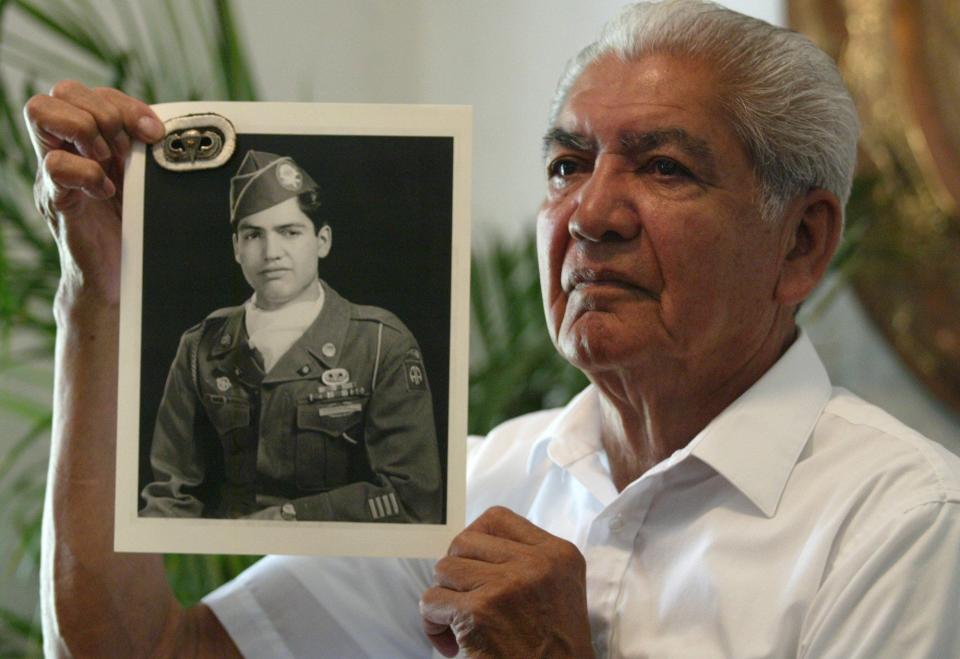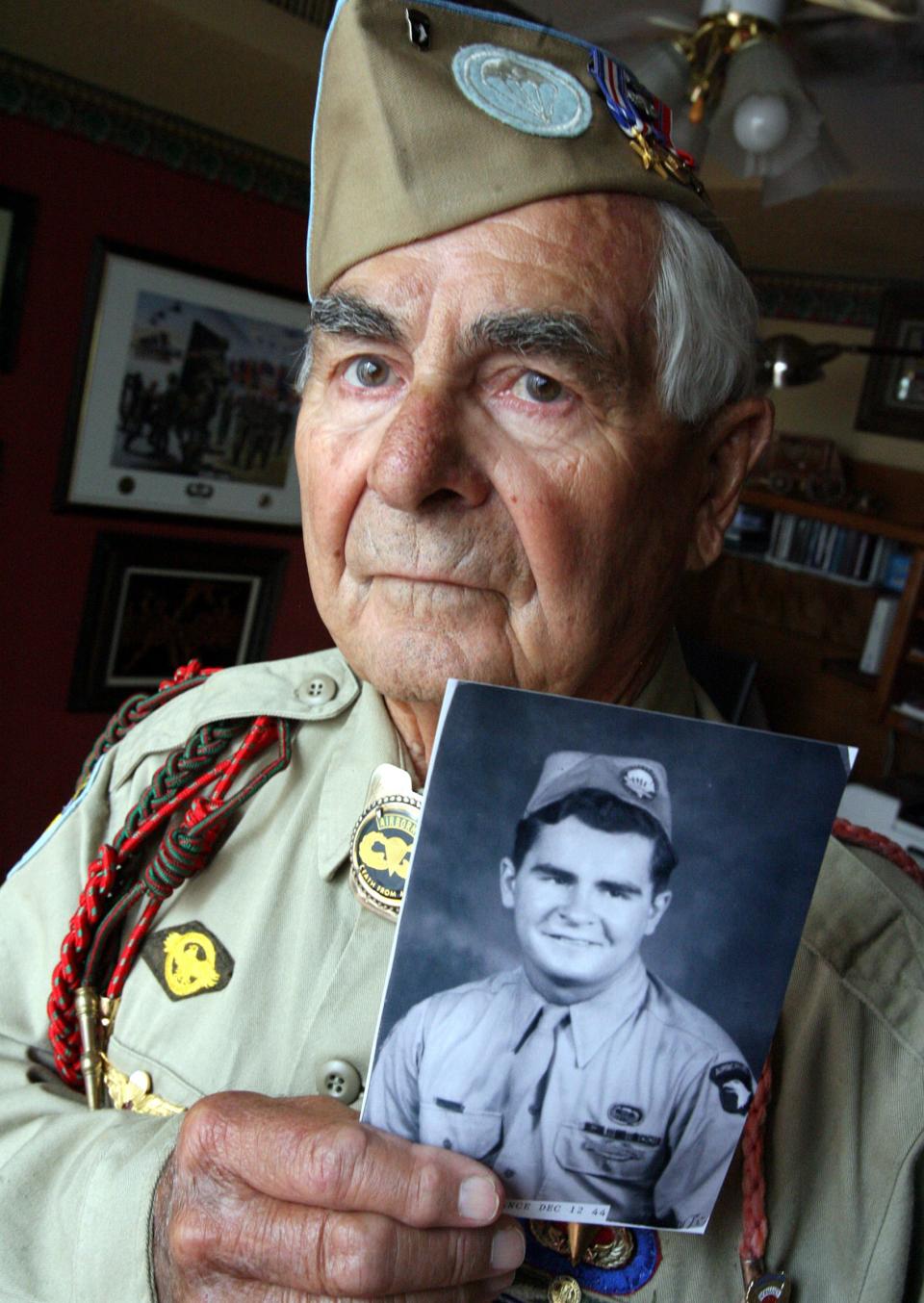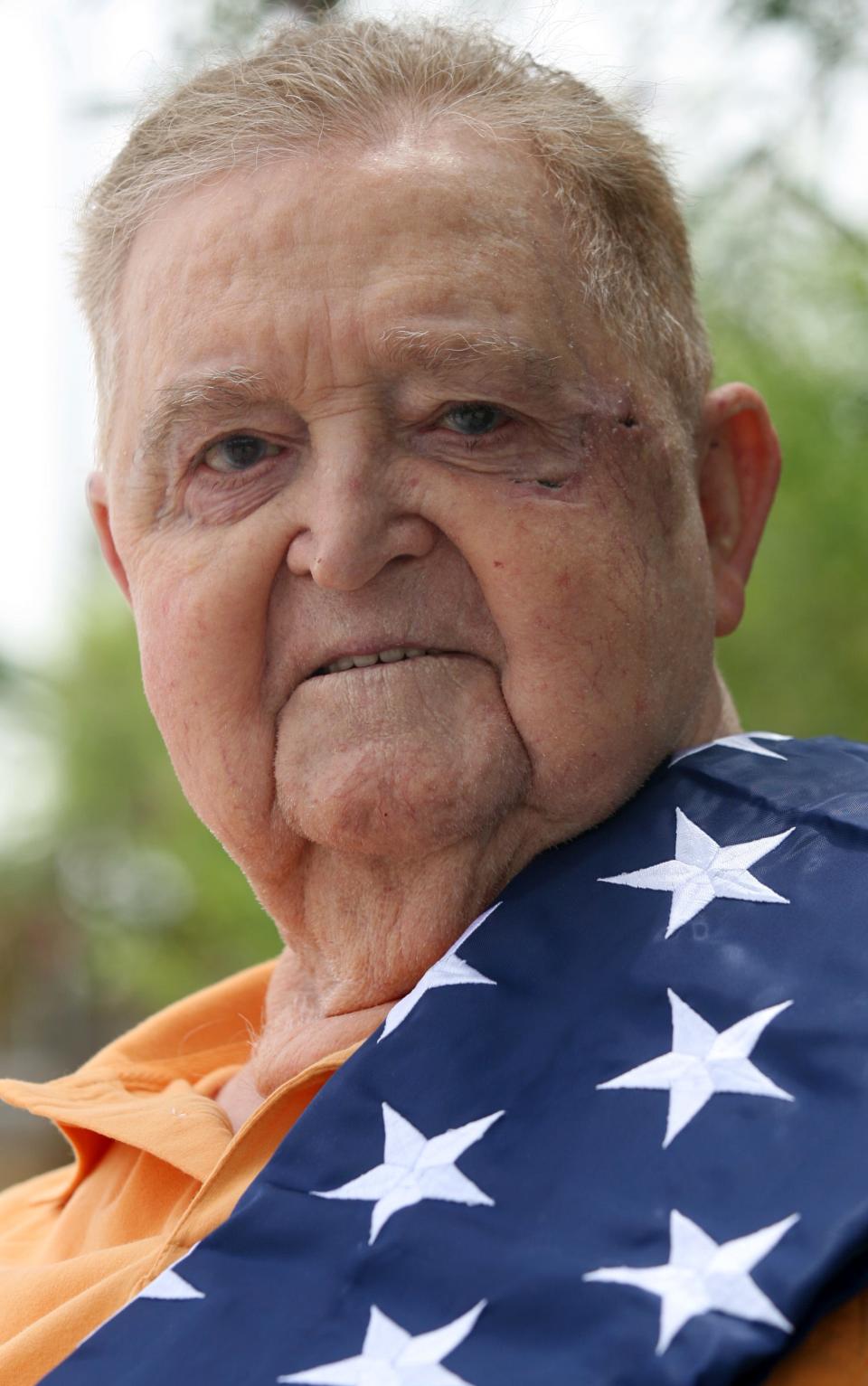El Paso WWII veterans remember horror, heroism of D-Day in 2009 interviews: Trish Long
- Oops!Something went wrong.Please try again later.
El Paso veterans remember D-Day
In this June 6, 2009, El Paso Times article, Zahira Torres interviews three D-Day veterans about their experiences. All three have since passed: Angel Romero in 2012 at the age of 87, Maynard Beamesderfer in 2016 at the age of 92, and Ray Burchfield in 2009 at the age of 93.
EL PASO ‒ Most of them were teenagers.
They were drafted into the military or joined to help turn the tide of World War II.
Sixty-five years ago today, on June 6, 1944, now known as D-Day, many of them had their first taste of combat.
Angel Romero

"I slept about halfway to Normandy, and when the plane started rocking and moving every which way, then I knew that we hadn't been trained correctly," Lower Valley resident Angel Romero, 84, said as he remembered the German gunfire that met American airplanes as they approached the French coast.
Then 19 and a paratrooper in the 82nd Airborne Division, Romero said no training could approximate combat.
"They never told us that we were going to be shot at by such good people," he said. "The German was a tremendous adversary. He wasn't a dumb Joe."
The United States entered World War II after the Japanese attack on Pearl Harbor on Dec. 7, 1941. Though battles were won against Japanese forces in the Pacific and Allied forces had defeated Italy and pushed Germany out of Sicily and Naples, the United States military was relying on D-Day to win the war.
America and her allies sent an estimated 5,300 ships and landing craft, 12,000 planes, and 150,000 soldiers to Normandy's 50-mile stretch of beaches to fight German soldiers.
It was a turning point in the war, but those fighting did not know it. More than 9,000 Allied soldiers died or were wounded on D-Day.
More: D-Day: Death knew no colors as American soldiers took part in WWII invasion, veterans say
Maynard Beamesderfer

Maynard Beamesderfer, then 21, was part of a small group of Pathfinders from the 101st Airborne Division. They parachuted in shortly before midnight June 5 near the town of Carentan, a German stronghold between Omaha and Utah beaches. They were to set up for thousands of Allied soldiers expected the next day.
The paratrooper remembers a warning issued to the troops by Gen. Dwight D. Eisenhower over a loudspeaker.
He told the 350 Pathfinders that their early entrance could leave them in the dangerous position of fighting thousands of German soldiers if the invasion was called off.
"We were only there for four to five hours ahead, but those four to five hours was, oh, it was bad," Beamesderfer, now 85, said as his eyes turned toward the floor. "There was machine-gun fire continuously and we were on our bellies, crawling, soaking wet. It is hard to explain how it was. How we did it. I don't know how we did it, but we did it."
On that day, Beamesderfer received his first of three wounds during World War II.
A bullet grazed his shoulder, and he received a concussion from English explosives that he and other soldiers were using. Later, as the fighting moved to Holland, he was bayoneted and shot. More combat in the Battle of the Bulge left him paralyzed from the waist down for more than a year.
The Santa Teresa resident received a Silver Star, two Bronze Stars and three Purple Hearts.
Beamesderfer, though, dismissed his injuries as "scrapes" compared with what happened to comrades.
"You see one of your friends, you are looking at him and, after all, half his head is blown up or he was shot in his stomach, is holding his stomach and knowing he can't live long. I mean things like this; you just can't explain to people how it really is. It's no picture."
But explanations from these brave men are crucial, said Bob Patrick, director of the Veterans History Project at the Library of Congress American Folklife Center. It is working to record personal history accounts of veterans of all wars and conflicts.
Patrick said stories like those of the El Pasoans who shared memories of D-Day with the El Paso Times are important to how people remember history.

"It is an event like D-Day that reminds us what they did," he said. "They saved the world."
About 1,000 World War II veterans are dying daily. Many have kept stories of the war, its casualties and their experiences closely guarded.
Some don't want to relive the images of fellow soldiers shot dead, or they don't want their grandchildren to hear about the atrocities at Nazi concentration camps.
Others haven't been asked, or they simply believe they were doing what everyone else was doing ‒ fighting and trying to survive.
More: El Pasoan Robert E. 'Bob' Chisolm Recalls D-Day
Ray Burchfield

One of those veterans is Ray Burchfield, who was a soldier in the 90th Infantry Division. Burchfield, 93, a Northeast resident, has shared little about the 11-day trip by ship from the United States to Utah Beach.
He does not talk about riding to shore on an amphibious military truck on D-Day afternoon, nor does he discuss how he became part of a makeshift rifle company that formed as soldiers on the front lines were killed or wounded.
He was one of the few left in his unit after D-Day who knew how to use a bazooka. Given that, he became a scout to alert other soldiers of what to anticipate as they marched ahead.
"I just more or less wanted to forget it," said Burchfield, who was 27 years old during the war. "I don't regret it. It just wasn't very pleasant to talk about. I didn't really care to see all those bodies on the side of the road. One of the boys from my company was in charge of putting them there, and it was a lot of them those first couple of months."
Burchfield's first child was born while he was at war, and he still recalls the sound of gunfire ringing in his ears.
Still, he is quick to list soldiers who had it tougher:
The ones at Omaha Beach, who saw more casualties. The first wave to face the Germans at Utah Beach. The pilots who shot down German planes before they killed more soldiers in the water and on the ground.
Yet that day was just the beginning of an arduous campaign that would continue to Holland and end with the Battle of the Bulge in Belgium's Ardennes Forest.
"The Battle of the Bulge was worse than Holland and D-Day put together," Beamesderfer said. "We didn't have the proper food, the proper clothing and our equipment was so poor. Sometimes you were so hungry you took the food off the dead, off of their rations or something, but you had to get it some way."
Yet the hunger, the wounds from battle and the memories that sometimes veterans wish to forget do not overcome the importance of what was accomplished in World War II, Angel Romero said.
A recipient of two Bronze Stars and three Purple Hearts, he said that when he is asked whether the war was worth it, he shows his questioners pictures of Nazi concentration camps.
"When you smell that ... ," Romero said, his voice trailing off. He could not finish his sentence as he pointed to a picture with the bodies of Jewish families piled atop each other.
After gazing at the picture for a few seconds, he continued.
"The pictures are erased, but the smell never goes away," he said. "The stench of human beings."
Trish Long may be reached at tlong@elpasotimes.com or 915-546-6179.
This article originally appeared on El Paso Times: El Paso WWII veterans in 2009 remember the horrors, heroism of D-Day
